The Little City’s Big Sewage Challenge – Part 2: Has Growth Paid For Growth?
Summary
Costs to purchase additional treatment capacity from Fairfax County and to build a vault to reduce peak flows from major rain events have risen from the initial estimate of $19.3 million to $20.1 million. The larger figure remains an “initial forecast,” according to City Manager Wyatt Shields. This expenditure would only meet the City’s sewage needs for the next two to three years.
City staff proposes financing this expense from within its sanitary sewer funds with a combination of $5.8 million in cash and $14.3 million in long-term debt. Debt service over 20 years would be paid for by increases in sewage user fees of 4% per year and availability fees for new sewer connections charged to developers, which may also rise.
City Council members pushed back on this funding plan, asking City staff to apply remaining American Rescue Plan Act (ARPA) funds and to explore borrowing from the City’s reserves to pay for needed sewer infrastructure. They also appeared to favor the creation of a program to disconnect the stormwater runoff from older houses into the sewer system. Council Member Erin Flynn pressed Mr. Shields to explain, “how we got here” and to be more transparent with the City Council and the public on this issue. She and Council Member David Snyder expressed concern that growth hasn’t paid for growth, though the City consistently claims that it does.
Financing two elements of sewer infrastructure
During its March 11, 2024, meeting, the City Council received a second briefing on the City’s sanitary sewer capacity, potential capital investment requirements, and a financing strategy. The first briefing at the Council’s February 5, 2024, work session detailed the infrastructure issues involved. (Read The Little City’s Big Sewage Challenge – Part 1 and the addendum, Managing Peak Flows, that follows this post.)
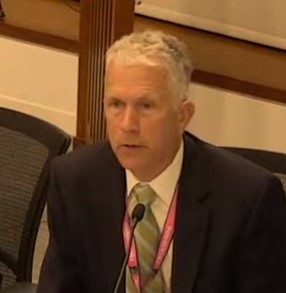
City Manager Wyatt Shield explained that the City must finance two elements of its sewer infrastructure:
- The purchase for $9.3 million of 500,000 gallons per day of additional treatment capacity from Fairfax County that is “directly caused by and related to development and growth in the City,” and
- The construction of a mitigation vault “to reliably comply with the request” from Fairfax that the City commit to reducing peak flows that occur during major rain events as a condition of the sale of more treatment capacity. Fairfax seeks to impose future capacity and financial consequences on Falls Church if peak flows are not effectively managed. The cost to build the vault, a flow equalization basin that City staff proposes to locate under the tennis courts at Cavalier Trail Park, is now estimated to cost $10.8 million.
Mr. Shields said staff proposes to fund this $20.1 million expenditure out of the City’s sanitary sewer funds through a combination of the remaining cash balances of $5.0 million from sewer availability fees already paid by developers and $0.8 million in sewage usage fees, and $14.3 million in long-term debt. This debt would be financed over 20 years with debt service paid for by availability fees and growth in the customer base that is the result of development.
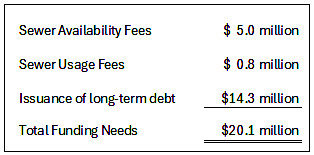
Proposed debt financing
City Chief Financial Officer Kiran Bawa described staff’s proposal to issue debt to meet these infrastructure needs in three tranches, based on the City’s cash flow projections: $4.3 million in FY2025, $5.0 million in FY2026, and $5.0 million in FY2027. This debt will consist of general obligation bonds at an estimated 4.0% interest rate, with 20 years maturity, and level principal payments. This financing includes operating costs for program management and flow equalization basin maintenance.
Sewage usage fee increases and a study of developer availability fees
There are two types of sewage fees – usage fees and availability fees. Usage fees are based on winter water usage volumes and are included in the quarterly consumer water bill. Availability fees are one-time fees paid for a new construction to be connected to the sewage system.
Beginning in FY2025, the City plans to increase sewage usage fees to homeowners and businesses by 4% per year, a rate Mr. Shields said would follow the Consumer Price Index (CPI) and enable the City to keep pace with staffing and inflation. The City also expects to analyze and may increase the availability fees it charges developers. These fees were raised in FY2024 for the first time in 10 years.
According to the staff report to City Council, “availability fees are assessed for new connections to the sewer system and are used to either expand sewer pipes or increase treatment plant capacity to ensure the system is able to meet the demands for service.” These fees are currently assessed as follows:
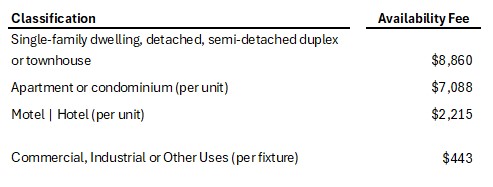
The City’s availability fees are identical to the fees Fairfax County charges. The County has published its schedule of availability fees through FY2028, which increase approximately 2% each year. As part of its proposed financing plan, City staff suggest revisiting availability fees every five years.
The staff report noted that the City has averaged $70,000 a year in availability fees for general redevelopment (single-family homes, small businesses, etc.) within Falls Church. This revenue stream is projected to be $85,000 starting in FY2025 due to the new availability fees rates instituted in FY2024 for by-right development.
Further the staff report said: “The City has collected $8.8 million in availability fees from major redevelopment in the City over the last four years (Founders Row I, Founders Row II, West Falls, and Broad and Washington), with another $1.7 million expected for future commercial fit-outs at those properties and another $2.4 million for the future committed Senior Living building and phase II projects at West Falls (total of $12.9 million).”
Much of this money has been spent: the City completed three projects in 2023 in connection with major developments that have used availability fees as a source of funding. These projects, which focus on the West Falls development, totaled $10,524,740.
Other possible sources of funding
Ms. Bawa identified other potential sources of funding to pay for the treatment capacity purchase and vault construction. Specifically, she said the City might redirect between $1 million and $3 million of its outstanding American Rescue Plan Act (ARPA) funding currently earmarked for stormwater projects and use $9 million in anticipated state grant funding for the stormwater work instead.
The City also might borrow from its general fund the $4.1 million still due in availability fees for projects already committed to as part of the Founders Row, West Falls Church, and Broad and Washington developments. Rather than issue external debt, the City could use its reserve balance and pay the general fund back as these fees are collected, Ms. Bawa said.
Finally, the City may collect availability fees for additional projects in future years that could be used to pay down the projected debt. However, Ms. Bawa stated that this source of funding was specifically excluded from the financing proposal as decisions on such projects have yet to be made by the City Council.
Noting that the Council would have to authorize the issuance of any bond, Ms. Bawa added that she expects the financing proposal to continue to evolve and use any time-restricted funding first.
Council reactions
In response to Council member questions, Zak Bradley, Director of the Department of Public Works, said the City is considering standing up a program to require owners of older homes whose stormwater runoff is tied into the sewer system to sever these connections. The City maintains that these connections are the primary source of rain derived inflow and infiltration (RDI&I) that results in excessive peak flows during major rain events.
City Manager Shields noted that staff are in the process of confirming whether the City would have the legal authority to require homeowners to disconnect their stormwater runoff from the sewer system. “I believe we do,” he said. “It would be great if we didn’t have to build the basin and could address this issue at the source. However, staff is concerned whether we can reliably get there [with a disconnection program] in a set amount of time. A lot of local governments have struggled to force homeowners to fix these sorts of things…. We’re just concerned that if there are going to be strict sanctions against the City, we need something that we are very confident is going to solve the problem. The vault would be the way to go, we think.”
Council Member Justine Underhill asked about the consequences of going above a peak flow of 4.3 in the future. Mr. Shields replied that these outcomes are still being negotiated but could include fines and Fairfax’s refusal of new connections and capacity.
Council Member Marybeth Connelly requested a map of the City’s sewer sub-sheds with development locations, and Mr. Bradley promised to provide them by the Council’s next meeting on this topic in May. “Almost all development will be in the Sisler’s and Tinner Hill sub-sheds,” Mr. Shields said.
Vice Mayor Debbie Schantz-Hiscott asked that the staff first present options rather than debt financing. Mr. Bradley responded that ARPA funding as well as an examination of the City’s FY2025 Capital Improvement Program (CIP) will be covered in the next briefing to Council.
Council Member Caroline Lian said she would like to see milestones associated with the issuance of debt by tranche. Mr. Bradley noted that the first tranche would be for the treatment capacity purchase. Ms. Lian also inquired if developer availability fees might be increased. Mr. Shields said, “It is the intent that availability fees should cover these kinds of expenses. We will increase the availability fees but want to do that with some analysis.” He added, “This plan will change if [additional] developments are approved, and their availability fees can be applied.”
Ms. Lian also asked how the Quinn project fits into the sewer system discussion. “The Quinn pump station to Arlington lets other projects use that infrastructure and buys us time to not buy from Fairfax,” Mr. Shields said.
Council Member Flynn challenges City Manager Shields
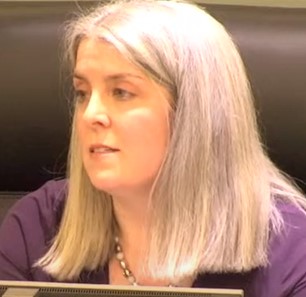
Noting that “the sewer capacity issues have been in plain view for the City staff since 2019,” Council Member Erin Flynn asked why Mr. Shields and his staff have not been more transparent with the City Council and the public about them. “I don’t want to lose sight of how we got here,” she said. Mr. Shields replied that the need for additional sewage treatment capacity “has been in the CIP for years,” adding, “we have another party on the other side of the table.”
Ms. Flynn asked, “Are you saying the County hasn’t been willing to sell us capacity?” Mr. Shields responded, “They have been willing but slow to do this. [Fairfax] would not give us a price…. Then in May 2023, they raised the issue of peak flows; that had not been previously discussed…. So, I would submit to you that this has been planned; it has been a thoughtful planning process, [and the need for capacity was] included in the CIP. But we have another party, an interjurisdictional partner, and that is what we’re working through now.”
Ms. Flynn continued, “For at least four years, we had a general ballpark of what the funding would be. I am trying to understand how we’ve gone this many years without allocating funding a) toward the $9.3 million and b) now we have a double expense from not planning for the $9.3 million and then getting hit with what we hope will only be $10 or so million and not more than that [for the vault]. Did any of the ARPA money go toward sewer?” she asked. Mr. Shields said, “We didn’t think it would need to be.” Ms. Flynn rejoined, “But what do you mean you didn’t think it would need to be…when the refrain has been ‘growth pays for growth?’”
“And I own that; I believe that growth should pay for growth,” Mr. Shields said. “I think two basic things are happening—the costs for the purchase are higher than we projected, and peak flow is something that was not planned at all.” He contended, “What we have presented to you is a financing plan where growth does pay for growth,” adding that technically in the model presented, “we don’t need ARPA money. Now, I think it’s a reasonable thing to discuss because we need to make these decisions right now.” He cited the additional money for stormwater that the City will receive from the state and said it could free up money to meet the City’s sanitary sewer needs. Mr. Shields said he did not believe that the City failed “to plan responsibly for this core infrastructure.”
Ms. Flynn said she agreed with comments by other Council members that the City should be aggressive in its use of ARPA dollars for the sanitary sewer system. “We had $7.7 million of remaining, unencumbered ARPA funds as of our February 20 work session,” she said. “A lot of [that] is in stormwater infrastructure. So before we’re talking about debt or issuing bonds, I would support taking additional dollars not only from the stormwater infrastructure but from other line items that have…several hundreds of thousands of dollars and start pulling from those places…to help finance this.”
Council Member Flynn anticipates that staff and the Council “will be back here within five years addressing this issue if we want any further growth.” She also suggested the aggressive use of a disconnection program in the Cedar Lane sewer sub-shed because of the significant RDI&I problems there. (Read the addendum Managing Peak Flows for background on these issues.) Mr. Bradley said he is confident the City can reach the future 3.6 and 3.1 peak factor targets with the vault engineering solution.
Ms. Flynn also asked about the status of conversations with Arlington regarding redirecting sewage flows to that County’s treatment facility. Mr. Bradley said that Falls Church and Arlington are continuing talks, but Arlington “has no concerns” about the recently approved Quinn development tying into their system. (Read City Council Approves the 10-Story Quinn Homestretch Project, Not Waiting For Information On Sewer Outcome.)
Council Member David Snyder said the fundamental question before the Council is “whether growth actually paid for growth” where the sewer infrastructure is concerned. Noting a comment from Mr. Bradley earlier in the work session that RDI&I stem chiefly from homes built in the 1950s and 1960s, Mr. Snyder asked, “How many houses from the ‘50s and ‘60s are left in the City?” He suggested that RDI&I seems a more political tool than reality. “I don’t see the evidence,” he said, particularly since average daily flows provided by Fairfax County for 2014 through 2023 appear to be largely flat. Mr. Snyder also indicated he favors use of reserve funds over debt financing.
Mayor Letty Hardi suggested keeping financing separate for what she sees as two different issues. The $9.3 million for the treatment capacity purchase is “a burden on development. Growth should pay for this.” However, the $10.8 million vault to address a legacy problem “is an issue we all own.” She further supported “doing what we can to stop RDI&I at the source” in an effort to “slow down the need to buy the additional 0.25 MGD [million gallons per day]” in three years at the estimated cost of another $5.0 million by implementing a disconnection program.
Video of the Erin Flynn and Wyatt Shields exchange (11m 48s)
References
- City Council Meeting, March 11, 2024, Work Session: Sanitary Sewer Financing Update. This video will not display properly on a small screen as it includes the meeting agenda.
- City Council Meeting, March 11, 2024, Work Session: Sanitary Sewer Financing Update, YouTube video of the Council Work Session.
- Sanitary Sewer Financing Update Staff Report 240311.
- Follow-up Falls Church Pulse Questions and City-County Answers-March 2024.
Addendum: Managing Peak Flows
Zak Bradley, Director of the Department of Public Works, provided additional background during the City Council’s March 11, 2024, sanitary sewer work session on the issue of peak flows and how construction of a flow equalization basin would reduce them.
Mr. Bradley noted that the City’s agreement with Fairfax, initially reached in 1978 and subsequently extended, currently covers treatment capacity of 1.0 million gallons per day (MGD) and a peak flow rate of 4.3 MGD (peak factor of 4.3). The 1.0 MGD daily flow rate is based on a monthly average, while the peak flow rate is a 5-minute measurement.
“The City has exceeded our contractual peak flow rate 6 times since 2019, all coincident with large rainstorms,” Mr. Bradley said. City Engineer Alan Dalton added that the City’s peak flows actually reached 10 MGD during the historic July 2019 storm.
The City and County discussed and discarded several approaches to meeting the City’s capacity needs in 2020, 2022, and 2023, including the possible swap of treatment capacity where the City would transfer some of its unused capacity in the Arlington Wastewater Treatment Plant for some of Fairfax County’s capacity in the AlexRenew Plant, and Fairfax’s proposal that Falls Church improve the County’s downstream pipes at an estimated cost to the City of $30 million.
The current proposal links the City’s purchase of any additional capacity from Fairfax County to a commitment from the City to meet new reduced peak flow rates. The County would agree to sell the City additional average daily flow capacity, but would not increase the peak flow rate above a 5.38 MGD peak flow cap as follows:
| Average Daily Flow (MGD) | Peak Factor | Peak Flow (MGD) | |
| Current City Allocation | 1.00 | 4.3 | 4.30 |
| Initial County Offer | 1.25 | 4.3 | 5.38 |
| Revised County Offer | 1.50 | 3.6 | 5.38 |
| With Future Purchase | 1.75 | 3.1 | 5.38 |
To stay at or below this cap, the City will have to lower its peak factor to 3.6 over the coming three years. In the future, the City must cut its peak factor further, to 3.1, to be able to purchase an additional 0.25 MGD in treatment capacity that is anticipated to be needed within five years. These reductions in peak flow are intended to reduce the likelihood of sewer overflows in the County system during heavy rain events.
“We have to reduce our peak factor to offset the new capacity we’re buying,” Mr. Dalton explained. “We have to reduce our peak factor to 4.3, which it never really was, it was always above that, but Fairfax allowed us to go down to 3.6 or 3.1 as we continued to buy more capacity, and that’s what the flow equalization basin [allows us to do].”
The City and County continue to discuss how peak flow will be measured—either at each of the three sewer sub-sheds that feed into Fairfax’s Tripps Run Sewer Shed or as combined flows, and how the new peak flow cap will be enforced over time and what happens if the City’s flows exceed the cap. Staff expect to conclude the City’s new agreement with Fairfax in April and to bring it to the City Council for approval in May. Maps and descriptions of the three sewer sub-sheds follow:
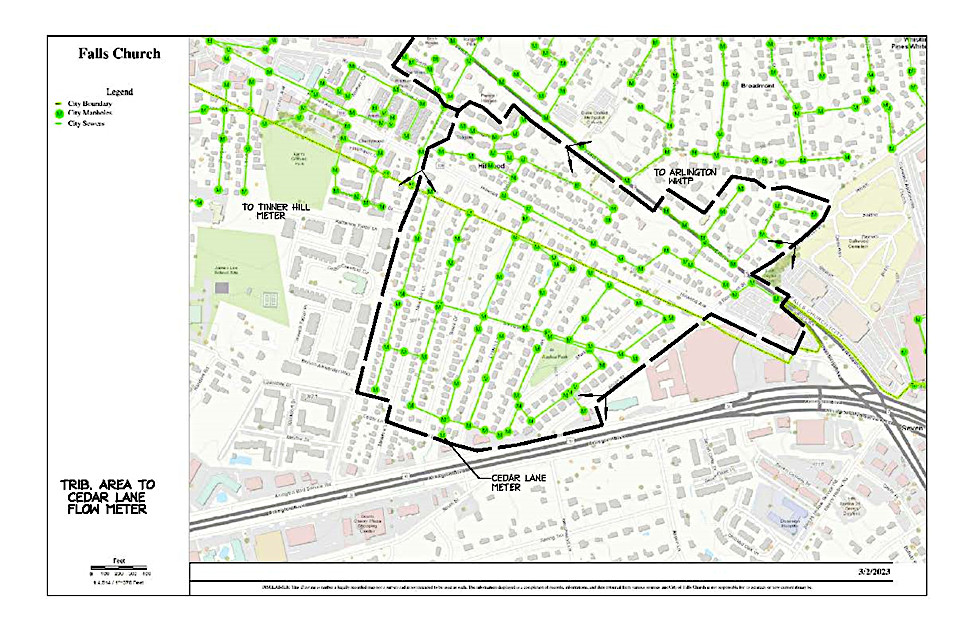
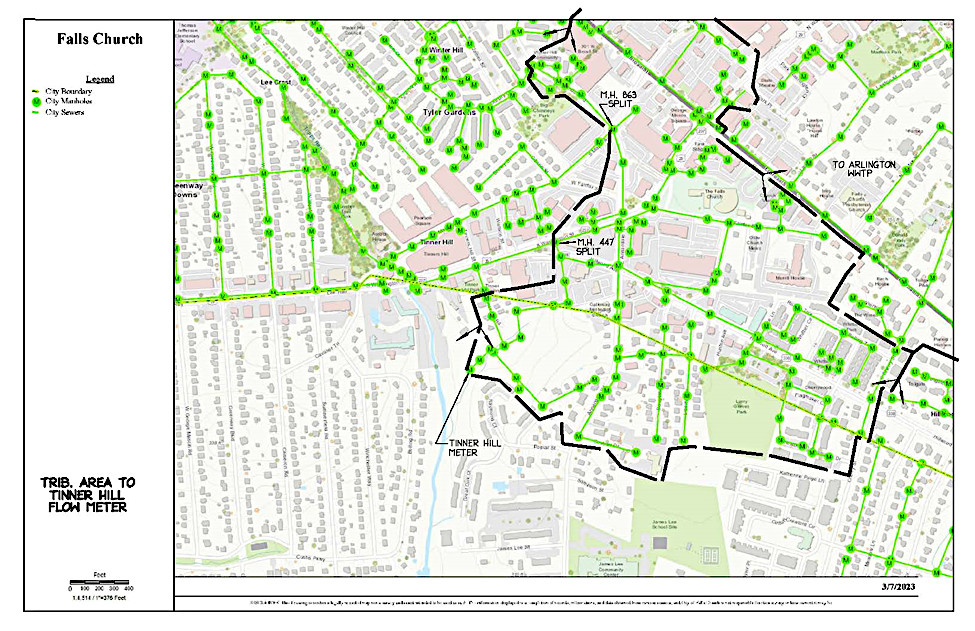

Vault versus a program to disconnect sources of stormwater runoff from the sewer system
City staff maintain that the best way to reduce peak flows caused by rainfall derived inflow and infiltration (RDI&I) is to construct the vault under Cavalier Trail Park. If approved by the City Council, this flow equalization basin would be designed in FY2025 and constructed in FY2026.
Asked by Council members and the Falls Church Pulse if RDI&I might be reduced at their source, staff said this would be both difficult and impractical. The staff attributes the primary source of RDI&I to older houses that connect their stormwater runoff directly to the sewer system.
“The City has made a decades-long effort to reduce RDI&I at its source,” the staff report said. However, the Department of Public Works has said they do not know how many such structures and connections there are in the City. Neither Falls Church nor Fairfax has a disconnection program in place, though questions from Council may prompt City staff to create a pilot program in the Cedar Lane sub-shed. (See the questions posed by the Pulse and the City’s and County’s responses in the Questions and Answers section beginning at line 266 of the staff report as well as our follow-up questions and answers.)



